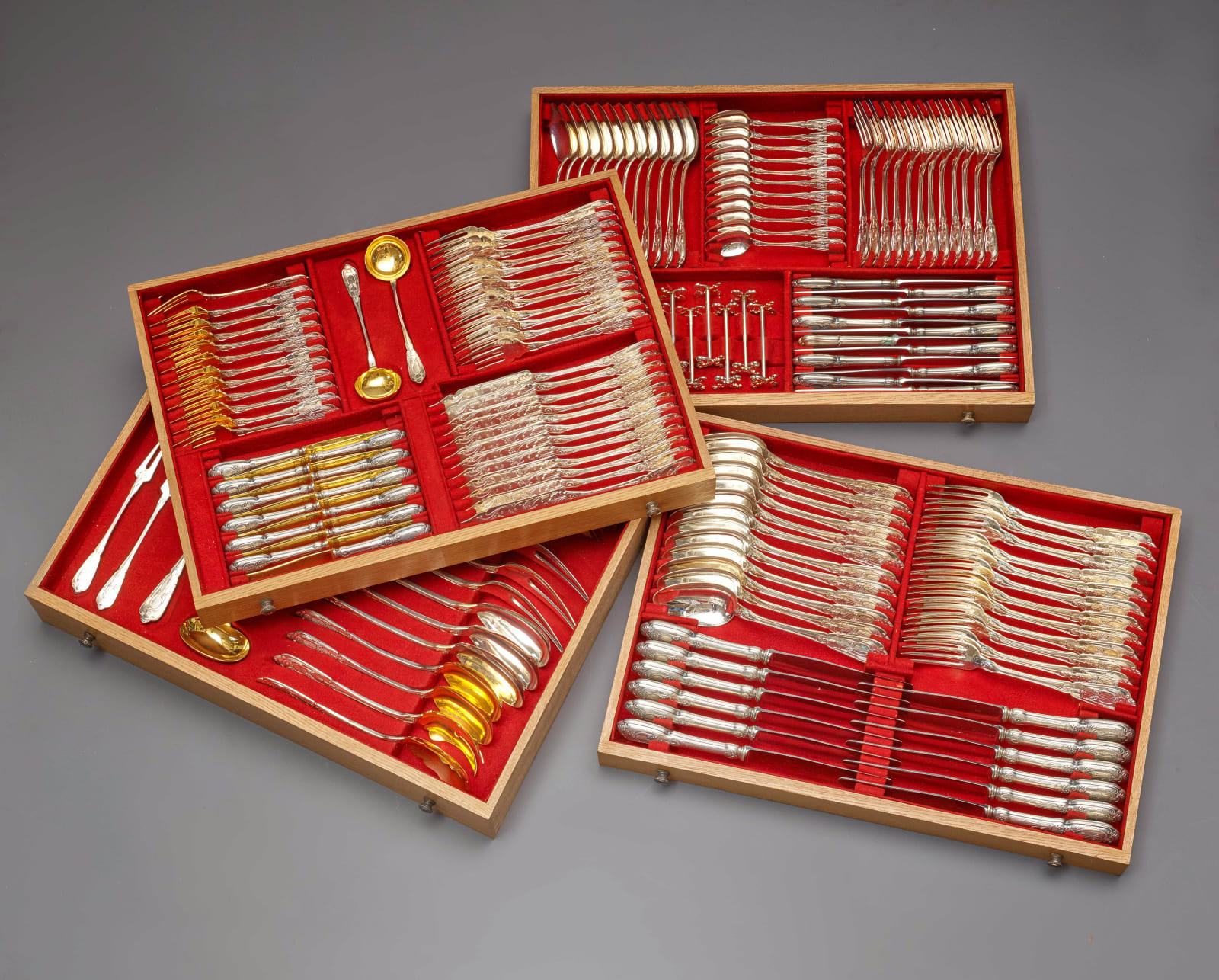Bossard & Sohn
A very fine Swiss early twentieth century Sterling silver and silver-gilt cutlery canteen by Bossard & Sohn each piece fully hallmarked. The service consisting of 12 large knives, 12 large forks, 12 large spoons, 12 small knives, 12 small forks, 12 dessert knives, 12 dessert forks, 12 dessert spoons, 12 fish knives, 12 fish forks, 11 tea spoons (1 missing), 12 knife rests, 2 serving spoons and 17 other serving pieces, housed in four fitted trays
Lucerne, Switzerland, dated 1906
Dating from 1906 and designed in the Classical manner, this superb Swiss silver and silver-gilt cutlery canteen for twelve settings was made by Bossard & Sohn of Lucerne. By 1906 or more specifically from 1901 up until 1915 the business was run by Karl Silvan Bossard (1846-1914) and his son Karl Thomas Bossard (1876-1934). They, together with Johann Kaspar Bossard (1849-1935) – with whom Karl Silvan is often confused, descended from a dynasty of Swiss goldsmiths dating back to the seventeenth century that included Karl Silvan’s father Johann Balthasar Bossard (1806-1869), a silver and goldsmith who set up in business in Lucerne, working from Hirschenplatz. The family originated from Zug and included several other members of note including the sculptor and illustrator Johann Michael Bossard (1874-1950) as well as the physician, mountaineer and art collector Gustav Bossard (1870-1943).
Having trained under his father, Karl Silvan Bossard went on to further his education, travelling to Geneva, Paris, London and America where he visited New York and Cincinnati. In 1867 he returned to work with his father in Lucerne and then on his father’s death in 1869, he became head of the workshop in the Hirschenplatz. During his travels abroad, Karl Silvan Bossard not only observed a variety of decorative arts but also began building up his own collection of antique silver that he eventually displayed and sold in his own premises, acquired in 1880, in Weggisgasse, Lucerne. Armed with a deep knowledge in history’s various styles and cultures, he began making silver that reflected past historical styles. In particular, he was drawn to the Gothic, Renaissance and Medieval periods though he also looked elsewhere to include Classical or Rococo styles. In turn these were reflected in his own creations, from grand Rococo style candelabra to the famous Renaissance style Ostrich Egg Cup of 1891 now in the Historisches Museum at Basel. Among his more important commissions, he created the Bishop’s Seal and Bishop’s Staff for the Bishopric of Basel, in addition to a golden hunting bowl for the Russian Tsar Alexander II. He also made various objects for several Swiss churches and monasteries as well as silver and gold trophies for a variety of clubs and societies. In addition to ecclesiastical and ceremonial pieces, Bossard also produced a wide range of silver and gold for domestic use, from jugs, plates and of course cutlery canteens.
Karl Silvan Bossard also gained great repute when showing his work at the public exhibitions where he won many medals and awards. Among them he received a distinction at the Schwizerischen Landesausstellung in Zurich, 1883, a silver medal at the Internationalen Ausstellung für Edelmetalle in Nuremberg, 1885 and a gold medal at the Paris Exposition Universelle in 1889. He also showed at the Schwizerischen Landesausstellung in Geneva, 1896 and was a member of the jury at the Paris Exposition Universelle in 1900. Like his father, Karl Thomas Bossard studied abroad, furthering his education in Paris, London and New York (1894-1897). He then went into partnership with his father when the concern was known as Bossard & Sohn (1901-1913), after which it was renamed Bossard Goldschmied, from 1913 up until 1934.
